Project Report: Promoting Sanitary Conditions in UK Care Services
VerifiedAdded on 2021/02/20
|10
|2158
|86
Project
AI Summary
This project report focuses on promoting sanitary conditions within UK Caring Services Ltd. It outlines the project's objectives, which include reducing the burden of diarrheal diseases. The report details the project's scope, quality standards, timeline (six months), budget (£250.00 with a £50.00 backup), and identified risks. The project life cycle includes initiation, planning, execution, and closure phases. The report further provides a project plan with defined roles, responsibilities, and critical path analysis. It includes time estimations for each project stage (initiation, planning, execution, and closure) and discusses the allocation of responsibilities among the project team members. The project's success is contingent upon the effective execution of each stage, including the critical path analysis to meet the desired goals and objectives. References from various books and journals are provided to support the project's findings.
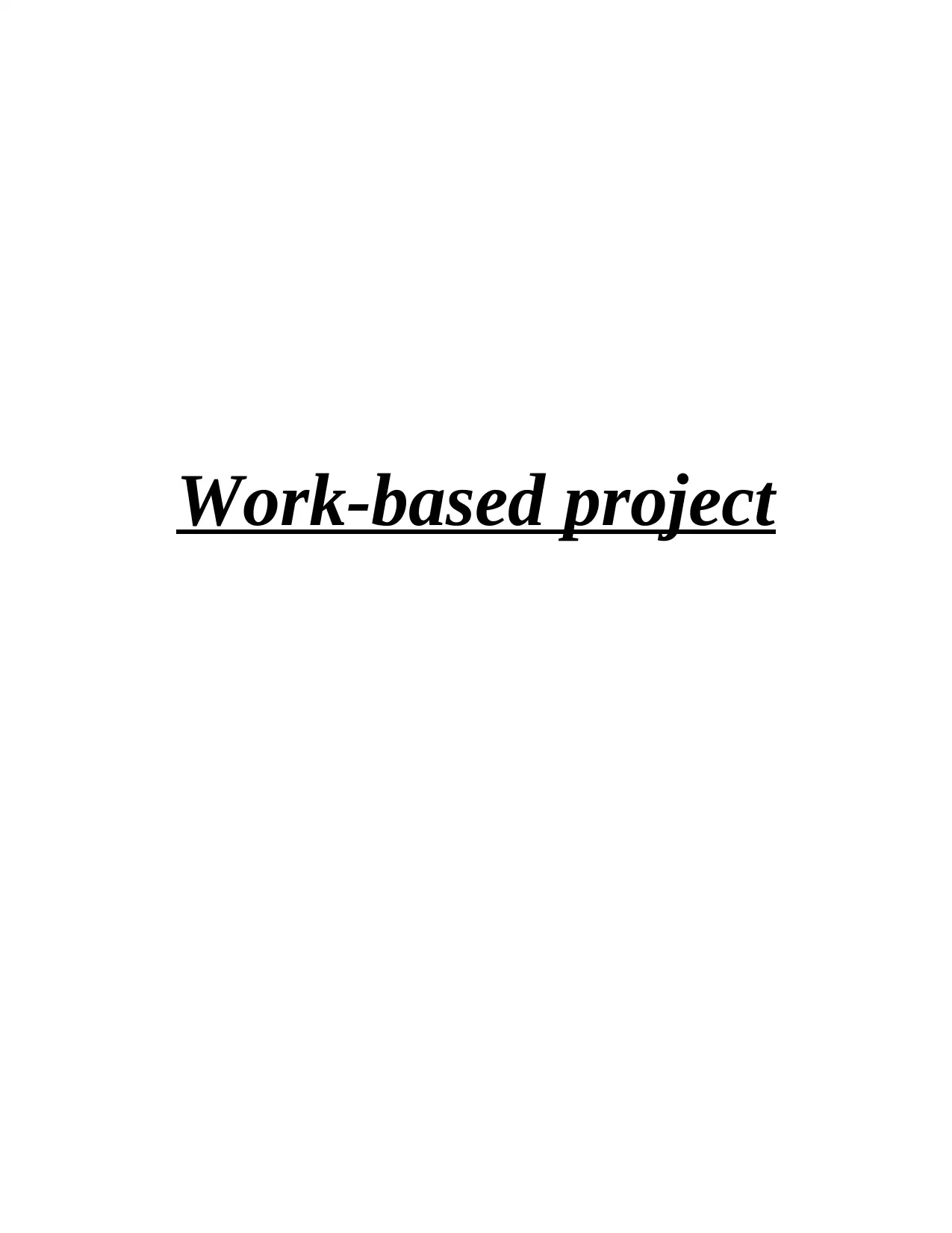
Work-based project
Paraphrase This Document
Need a fresh take? Get an instant paraphrase of this document with our AI Paraphraser
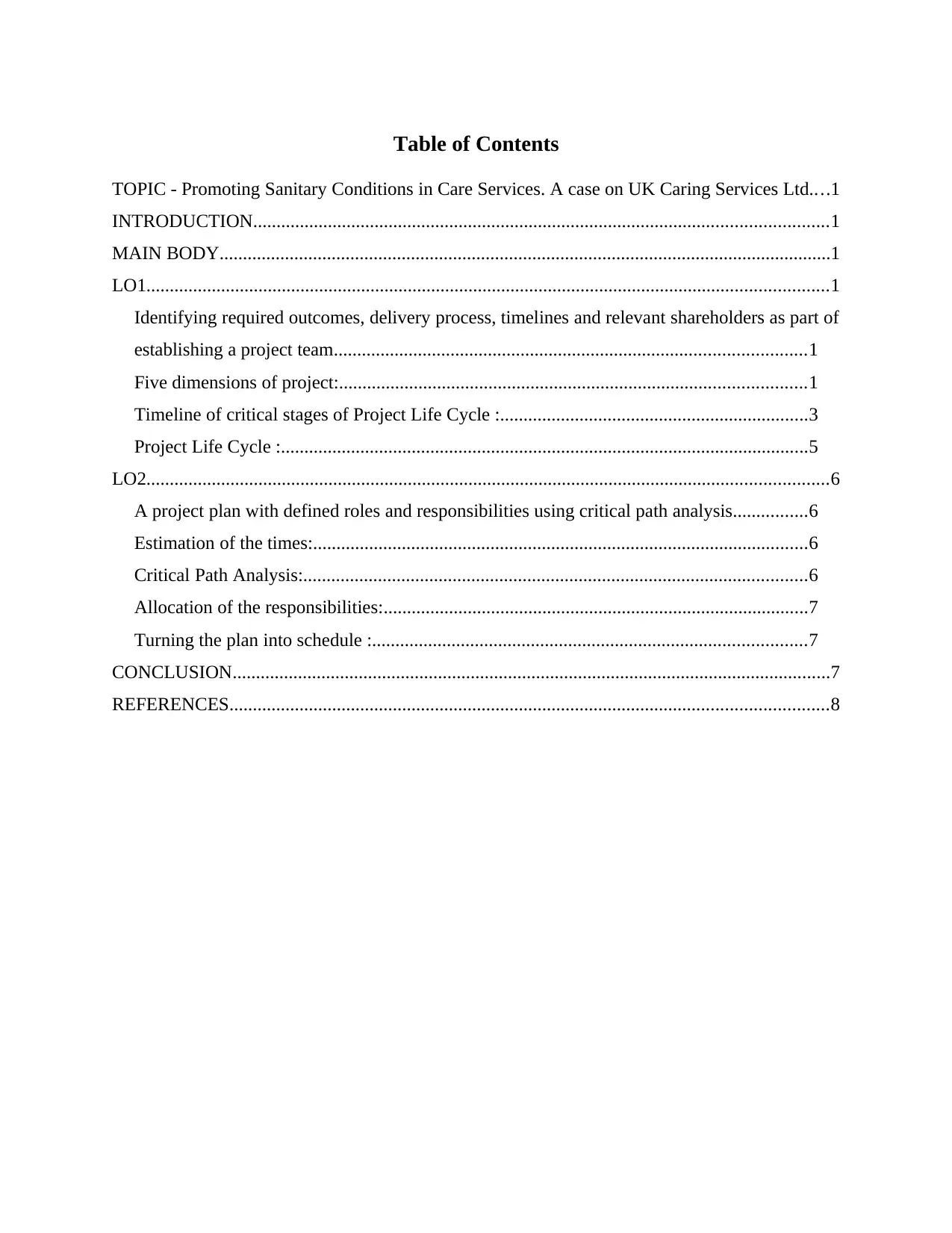
Table of Contents
TOPIC - Promoting Sanitary Conditions in Care Services. A case on UK Caring Services Ltd....1
INTRODUCTION...........................................................................................................................1
MAIN BODY...................................................................................................................................1
LO1..................................................................................................................................................1
Identifying required outcomes, delivery process, timelines and relevant shareholders as part of
establishing a project team.....................................................................................................1
Five dimensions of project:....................................................................................................1
Timeline of critical stages of Project Life Cycle :..................................................................3
Project Life Cycle :.................................................................................................................5
LO2..................................................................................................................................................6
A project plan with defined roles and responsibilities using critical path analysis................6
Estimation of the times:..........................................................................................................6
Critical Path Analysis:............................................................................................................6
Allocation of the responsibilities:...........................................................................................7
Turning the plan into schedule :.............................................................................................7
CONCLUSION................................................................................................................................7
REFERENCES................................................................................................................................8
TOPIC - Promoting Sanitary Conditions in Care Services. A case on UK Caring Services Ltd....1
INTRODUCTION...........................................................................................................................1
MAIN BODY...................................................................................................................................1
LO1..................................................................................................................................................1
Identifying required outcomes, delivery process, timelines and relevant shareholders as part of
establishing a project team.....................................................................................................1
Five dimensions of project:....................................................................................................1
Timeline of critical stages of Project Life Cycle :..................................................................3
Project Life Cycle :.................................................................................................................5
LO2..................................................................................................................................................6
A project plan with defined roles and responsibilities using critical path analysis................6
Estimation of the times:..........................................................................................................6
Critical Path Analysis:............................................................................................................6
Allocation of the responsibilities:...........................................................................................7
Turning the plan into schedule :.............................................................................................7
CONCLUSION................................................................................................................................7
REFERENCES................................................................................................................................8
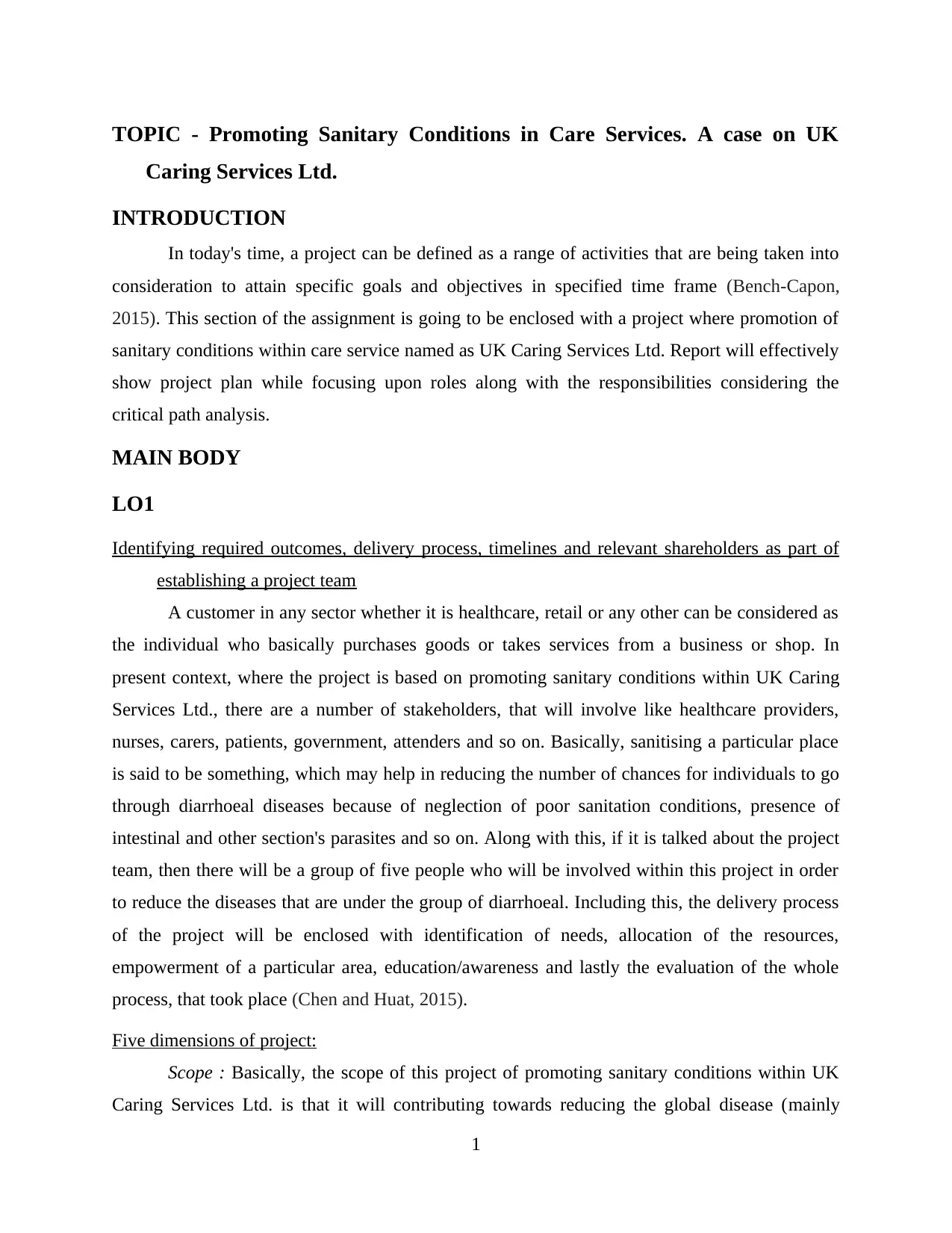
TOPIC - Promoting Sanitary Conditions in Care Services. A case on UK
Caring Services Ltd.
INTRODUCTION
In today's time, a project can be defined as a range of activities that are being taken into
consideration to attain specific goals and objectives in specified time frame (Bench-Capon,
2015). This section of the assignment is going to be enclosed with a project where promotion of
sanitary conditions within care service named as UK Caring Services Ltd. Report will effectively
show project plan while focusing upon roles along with the responsibilities considering the
critical path analysis.
MAIN BODY
LO1
Identifying required outcomes, delivery process, timelines and relevant shareholders as part of
establishing a project team
A customer in any sector whether it is healthcare, retail or any other can be considered as
the individual who basically purchases goods or takes services from a business or shop. In
present context, where the project is based on promoting sanitary conditions within UK Caring
Services Ltd., there are a number of stakeholders, that will involve like healthcare providers,
nurses, carers, patients, government, attenders and so on. Basically, sanitising a particular place
is said to be something, which may help in reducing the number of chances for individuals to go
through diarrhoeal diseases because of neglection of poor sanitation conditions, presence of
intestinal and other section's parasites and so on. Along with this, if it is talked about the project
team, then there will be a group of five people who will be involved within this project in order
to reduce the diseases that are under the group of diarrhoeal. Including this, the delivery process
of the project will be enclosed with identification of needs, allocation of the resources,
empowerment of a particular area, education/awareness and lastly the evaluation of the whole
process, that took place (Chen and Huat, 2015).
Five dimensions of project:
Scope : Basically, the scope of this project of promoting sanitary conditions within UK
Caring Services Ltd. is that it will contributing towards reducing the global disease (mainly
1
Caring Services Ltd.
INTRODUCTION
In today's time, a project can be defined as a range of activities that are being taken into
consideration to attain specific goals and objectives in specified time frame (Bench-Capon,
2015). This section of the assignment is going to be enclosed with a project where promotion of
sanitary conditions within care service named as UK Caring Services Ltd. Report will effectively
show project plan while focusing upon roles along with the responsibilities considering the
critical path analysis.
MAIN BODY
LO1
Identifying required outcomes, delivery process, timelines and relevant shareholders as part of
establishing a project team
A customer in any sector whether it is healthcare, retail or any other can be considered as
the individual who basically purchases goods or takes services from a business or shop. In
present context, where the project is based on promoting sanitary conditions within UK Caring
Services Ltd., there are a number of stakeholders, that will involve like healthcare providers,
nurses, carers, patients, government, attenders and so on. Basically, sanitising a particular place
is said to be something, which may help in reducing the number of chances for individuals to go
through diarrhoeal diseases because of neglection of poor sanitation conditions, presence of
intestinal and other section's parasites and so on. Along with this, if it is talked about the project
team, then there will be a group of five people who will be involved within this project in order
to reduce the diseases that are under the group of diarrhoeal. Including this, the delivery process
of the project will be enclosed with identification of needs, allocation of the resources,
empowerment of a particular area, education/awareness and lastly the evaluation of the whole
process, that took place (Chen and Huat, 2015).
Five dimensions of project:
Scope : Basically, the scope of this project of promoting sanitary conditions within UK
Caring Services Ltd. is that it will contributing towards reducing the global disease (mainly
1
⊘ This is a preview!⊘
Do you want full access?
Subscribe today to unlock all pages.

Trusted by 1+ million students worldwide
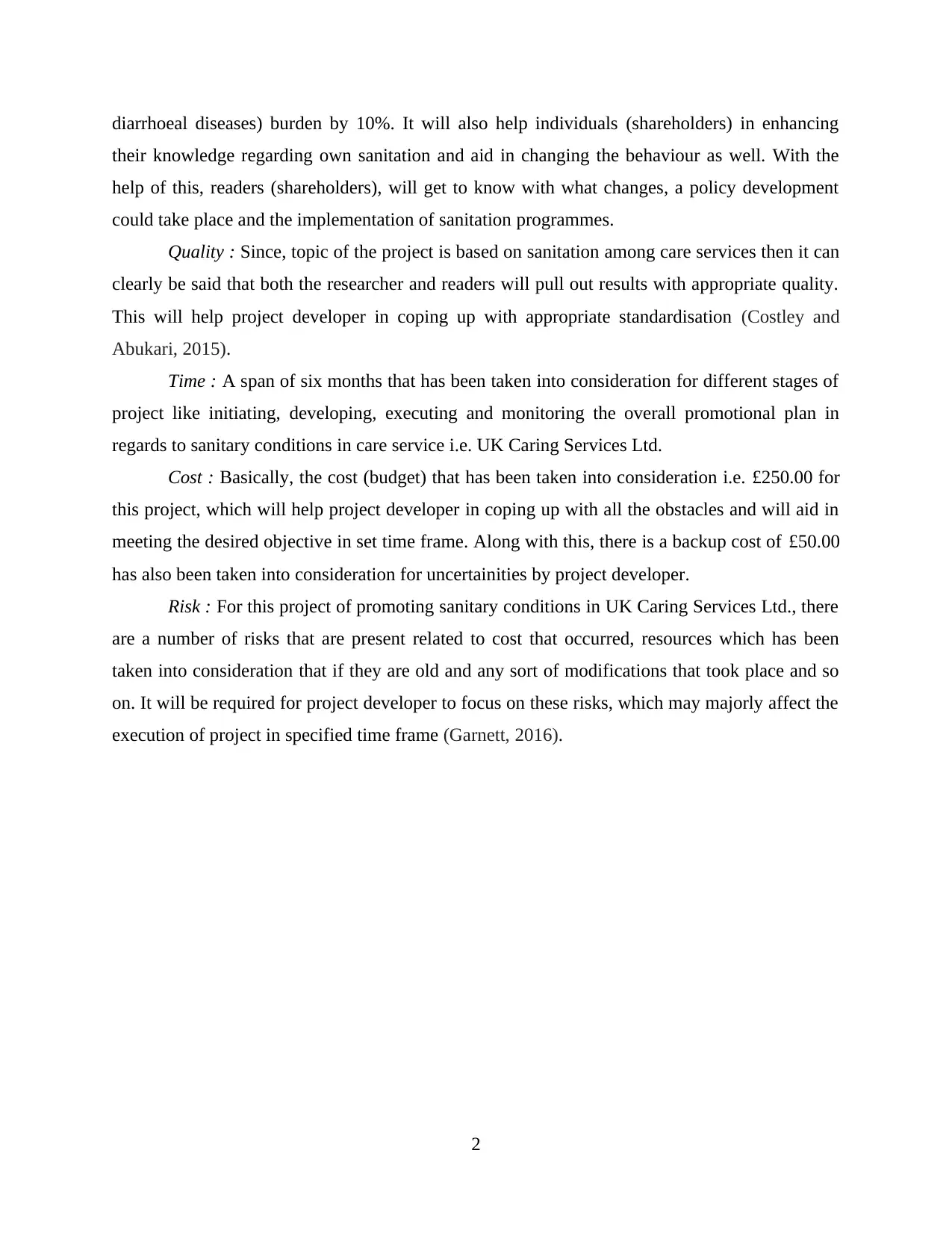
diarrhoeal diseases) burden by 10%. It will also help individuals (shareholders) in enhancing
their knowledge regarding own sanitation and aid in changing the behaviour as well. With the
help of this, readers (shareholders), will get to know with what changes, a policy development
could take place and the implementation of sanitation programmes.
Quality : Since, topic of the project is based on sanitation among care services then it can
clearly be said that both the researcher and readers will pull out results with appropriate quality.
This will help project developer in coping up with appropriate standardisation (Costley and
Abukari, 2015).
Time : A span of six months that has been taken into consideration for different stages of
project like initiating, developing, executing and monitoring the overall promotional plan in
regards to sanitary conditions in care service i.e. UK Caring Services Ltd.
Cost : Basically, the cost (budget) that has been taken into consideration i.e. £250.00 for
this project, which will help project developer in coping up with all the obstacles and will aid in
meeting the desired objective in set time frame. Along with this, there is a backup cost of £50.00
has also been taken into consideration for uncertainities by project developer.
Risk : For this project of promoting sanitary conditions in UK Caring Services Ltd., there
are a number of risks that are present related to cost that occurred, resources which has been
taken into consideration that if they are old and any sort of modifications that took place and so
on. It will be required for project developer to focus on these risks, which may majorly affect the
execution of project in specified time frame (Garnett, 2016).
2
their knowledge regarding own sanitation and aid in changing the behaviour as well. With the
help of this, readers (shareholders), will get to know with what changes, a policy development
could take place and the implementation of sanitation programmes.
Quality : Since, topic of the project is based on sanitation among care services then it can
clearly be said that both the researcher and readers will pull out results with appropriate quality.
This will help project developer in coping up with appropriate standardisation (Costley and
Abukari, 2015).
Time : A span of six months that has been taken into consideration for different stages of
project like initiating, developing, executing and monitoring the overall promotional plan in
regards to sanitary conditions in care service i.e. UK Caring Services Ltd.
Cost : Basically, the cost (budget) that has been taken into consideration i.e. £250.00 for
this project, which will help project developer in coping up with all the obstacles and will aid in
meeting the desired objective in set time frame. Along with this, there is a backup cost of £50.00
has also been taken into consideration for uncertainities by project developer.
Risk : For this project of promoting sanitary conditions in UK Caring Services Ltd., there
are a number of risks that are present related to cost that occurred, resources which has been
taken into consideration that if they are old and any sort of modifications that took place and so
on. It will be required for project developer to focus on these risks, which may majorly affect the
execution of project in specified time frame (Garnett, 2016).
2
Paraphrase This Document
Need a fresh take? Get an instant paraphrase of this document with our AI Paraphraser
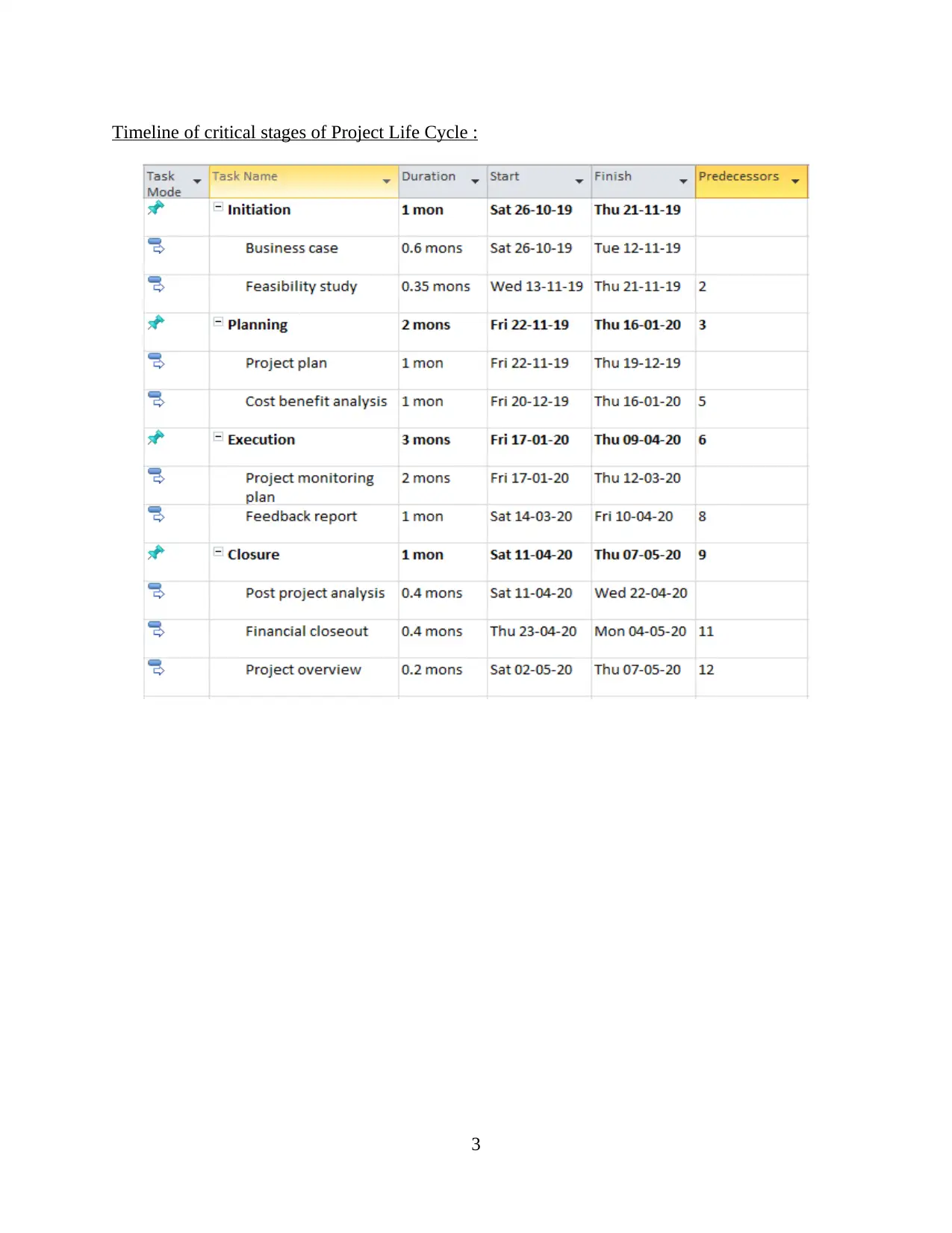
Timeline of critical stages of Project Life Cycle :
3
3
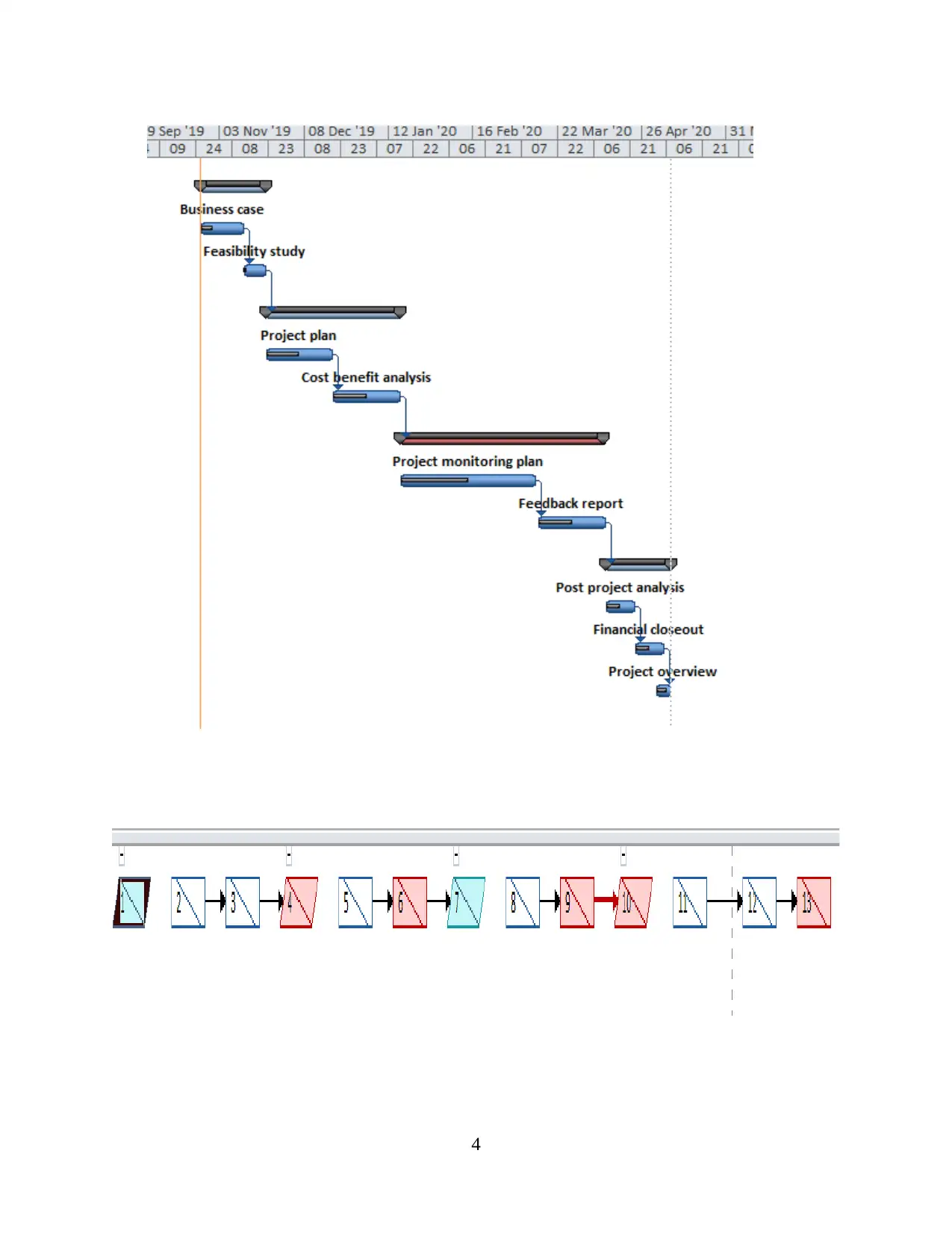
4
⊘ This is a preview!⊘
Do you want full access?
Subscribe today to unlock all pages.

Trusted by 1+ million students worldwide
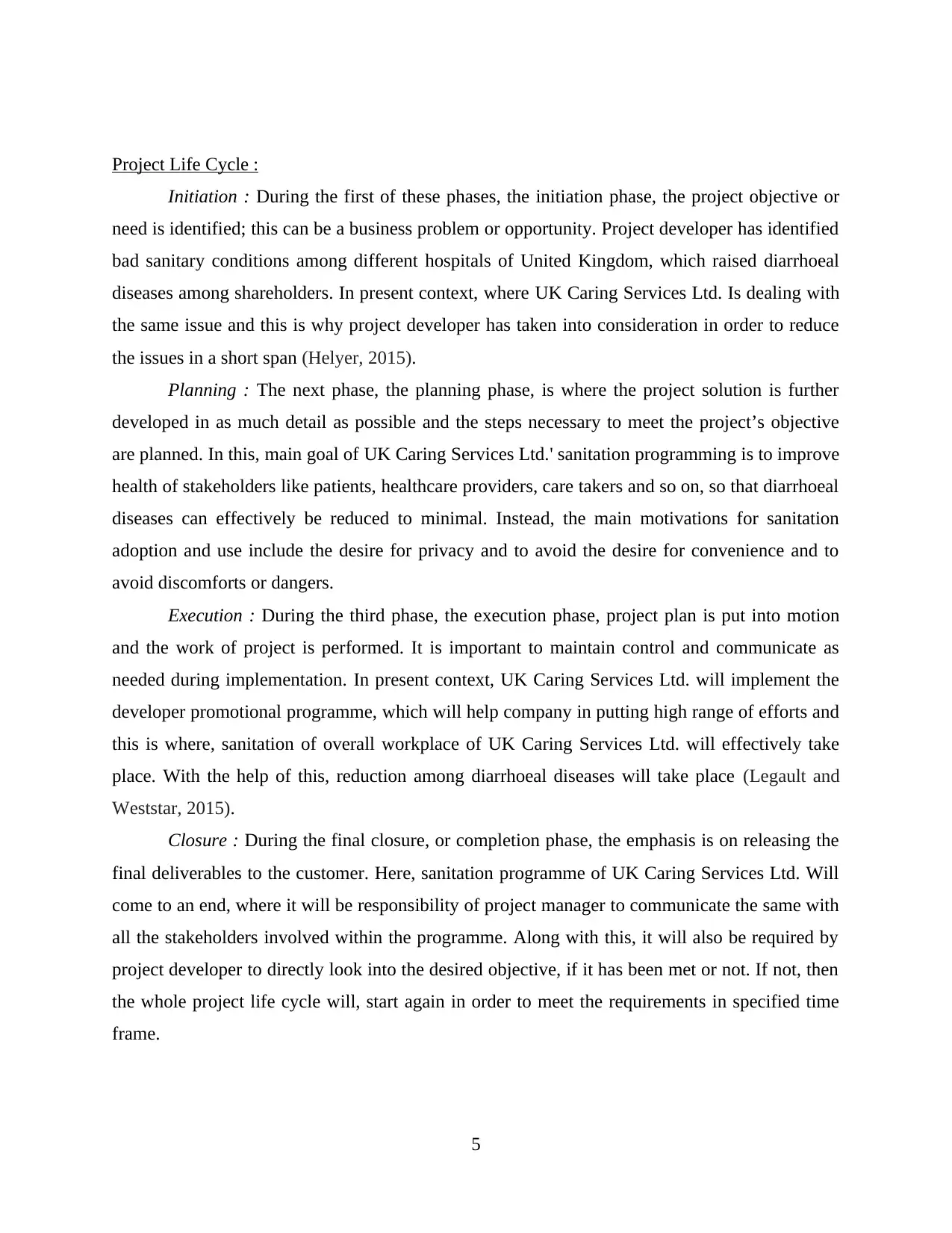
Project Life Cycle :
Initiation : During the first of these phases, the initiation phase, the project objective or
need is identified; this can be a business problem or opportunity. Project developer has identified
bad sanitary conditions among different hospitals of United Kingdom, which raised diarrhoeal
diseases among shareholders. In present context, where UK Caring Services Ltd. Is dealing with
the same issue and this is why project developer has taken into consideration in order to reduce
the issues in a short span (Helyer, 2015).
Planning : The next phase, the planning phase, is where the project solution is further
developed in as much detail as possible and the steps necessary to meet the project’s objective
are planned. In this, main goal of UK Caring Services Ltd.' sanitation programming is to improve
health of stakeholders like patients, healthcare providers, care takers and so on, so that diarrhoeal
diseases can effectively be reduced to minimal. Instead, the main motivations for sanitation
adoption and use include the desire for privacy and to avoid the desire for convenience and to
avoid discomforts or dangers.
Execution : During the third phase, the execution phase, project plan is put into motion
and the work of project is performed. It is important to maintain control and communicate as
needed during implementation. In present context, UK Caring Services Ltd. will implement the
developer promotional programme, which will help company in putting high range of efforts and
this is where, sanitation of overall workplace of UK Caring Services Ltd. will effectively take
place. With the help of this, reduction among diarrhoeal diseases will take place (Legault and
Weststar, 2015).
Closure : During the final closure, or completion phase, the emphasis is on releasing the
final deliverables to the customer. Here, sanitation programme of UK Caring Services Ltd. Will
come to an end, where it will be responsibility of project manager to communicate the same with
all the stakeholders involved within the programme. Along with this, it will also be required by
project developer to directly look into the desired objective, if it has been met or not. If not, then
the whole project life cycle will, start again in order to meet the requirements in specified time
frame.
5
Initiation : During the first of these phases, the initiation phase, the project objective or
need is identified; this can be a business problem or opportunity. Project developer has identified
bad sanitary conditions among different hospitals of United Kingdom, which raised diarrhoeal
diseases among shareholders. In present context, where UK Caring Services Ltd. Is dealing with
the same issue and this is why project developer has taken into consideration in order to reduce
the issues in a short span (Helyer, 2015).
Planning : The next phase, the planning phase, is where the project solution is further
developed in as much detail as possible and the steps necessary to meet the project’s objective
are planned. In this, main goal of UK Caring Services Ltd.' sanitation programming is to improve
health of stakeholders like patients, healthcare providers, care takers and so on, so that diarrhoeal
diseases can effectively be reduced to minimal. Instead, the main motivations for sanitation
adoption and use include the desire for privacy and to avoid the desire for convenience and to
avoid discomforts or dangers.
Execution : During the third phase, the execution phase, project plan is put into motion
and the work of project is performed. It is important to maintain control and communicate as
needed during implementation. In present context, UK Caring Services Ltd. will implement the
developer promotional programme, which will help company in putting high range of efforts and
this is where, sanitation of overall workplace of UK Caring Services Ltd. will effectively take
place. With the help of this, reduction among diarrhoeal diseases will take place (Legault and
Weststar, 2015).
Closure : During the final closure, or completion phase, the emphasis is on releasing the
final deliverables to the customer. Here, sanitation programme of UK Caring Services Ltd. Will
come to an end, where it will be responsibility of project manager to communicate the same with
all the stakeholders involved within the programme. Along with this, it will also be required by
project developer to directly look into the desired objective, if it has been met or not. If not, then
the whole project life cycle will, start again in order to meet the requirements in specified time
frame.
5
Paraphrase This Document
Need a fresh take? Get an instant paraphrase of this document with our AI Paraphraser
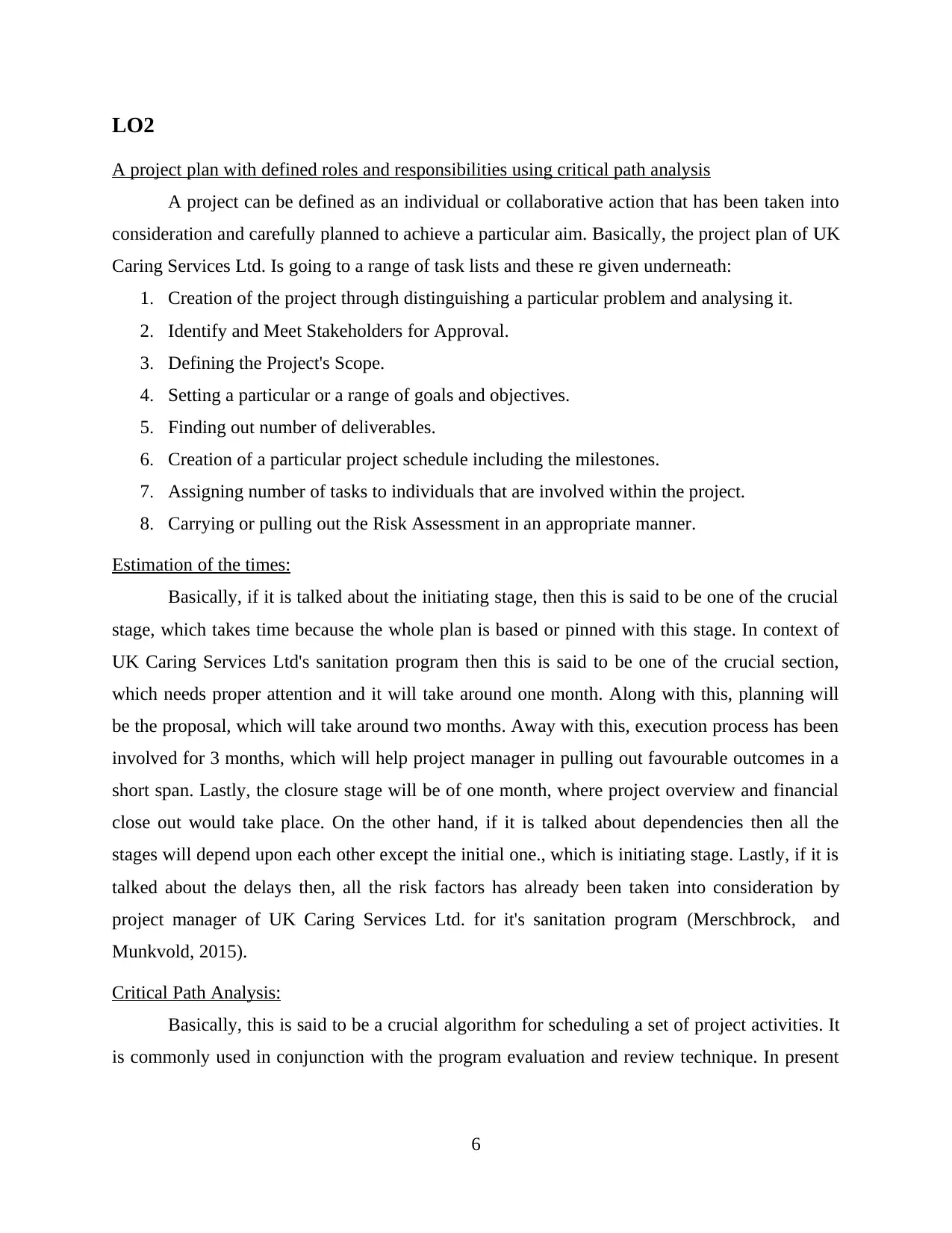
LO2
A project plan with defined roles and responsibilities using critical path analysis
A project can be defined as an individual or collaborative action that has been taken into
consideration and carefully planned to achieve a particular aim. Basically, the project plan of UK
Caring Services Ltd. Is going to a range of task lists and these re given underneath:
1. Creation of the project through distinguishing a particular problem and analysing it.
2. Identify and Meet Stakeholders for Approval.
3. Defining the Project's Scope.
4. Setting a particular or a range of goals and objectives.
5. Finding out number of deliverables.
6. Creation of a particular project schedule including the milestones.
7. Assigning number of tasks to individuals that are involved within the project.
8. Carrying or pulling out the Risk Assessment in an appropriate manner.
Estimation of the times:
Basically, if it is talked about the initiating stage, then this is said to be one of the crucial
stage, which takes time because the whole plan is based or pinned with this stage. In context of
UK Caring Services Ltd's sanitation program then this is said to be one of the crucial section,
which needs proper attention and it will take around one month. Along with this, planning will
be the proposal, which will take around two months. Away with this, execution process has been
involved for 3 months, which will help project manager in pulling out favourable outcomes in a
short span. Lastly, the closure stage will be of one month, where project overview and financial
close out would take place. On the other hand, if it is talked about dependencies then all the
stages will depend upon each other except the initial one., which is initiating stage. Lastly, if it is
talked about the delays then, all the risk factors has already been taken into consideration by
project manager of UK Caring Services Ltd. for it's sanitation program (Merschbrock, and
Munkvold, 2015).
Critical Path Analysis:
Basically, this is said to be a crucial algorithm for scheduling a set of project activities. It
is commonly used in conjunction with the program evaluation and review technique. In present
6
A project plan with defined roles and responsibilities using critical path analysis
A project can be defined as an individual or collaborative action that has been taken into
consideration and carefully planned to achieve a particular aim. Basically, the project plan of UK
Caring Services Ltd. Is going to a range of task lists and these re given underneath:
1. Creation of the project through distinguishing a particular problem and analysing it.
2. Identify and Meet Stakeholders for Approval.
3. Defining the Project's Scope.
4. Setting a particular or a range of goals and objectives.
5. Finding out number of deliverables.
6. Creation of a particular project schedule including the milestones.
7. Assigning number of tasks to individuals that are involved within the project.
8. Carrying or pulling out the Risk Assessment in an appropriate manner.
Estimation of the times:
Basically, if it is talked about the initiating stage, then this is said to be one of the crucial
stage, which takes time because the whole plan is based or pinned with this stage. In context of
UK Caring Services Ltd's sanitation program then this is said to be one of the crucial section,
which needs proper attention and it will take around one month. Along with this, planning will
be the proposal, which will take around two months. Away with this, execution process has been
involved for 3 months, which will help project manager in pulling out favourable outcomes in a
short span. Lastly, the closure stage will be of one month, where project overview and financial
close out would take place. On the other hand, if it is talked about dependencies then all the
stages will depend upon each other except the initial one., which is initiating stage. Lastly, if it is
talked about the delays then, all the risk factors has already been taken into consideration by
project manager of UK Caring Services Ltd. for it's sanitation program (Merschbrock, and
Munkvold, 2015).
Critical Path Analysis:
Basically, this is said to be a crucial algorithm for scheduling a set of project activities. It
is commonly used in conjunction with the program evaluation and review technique. In present
6
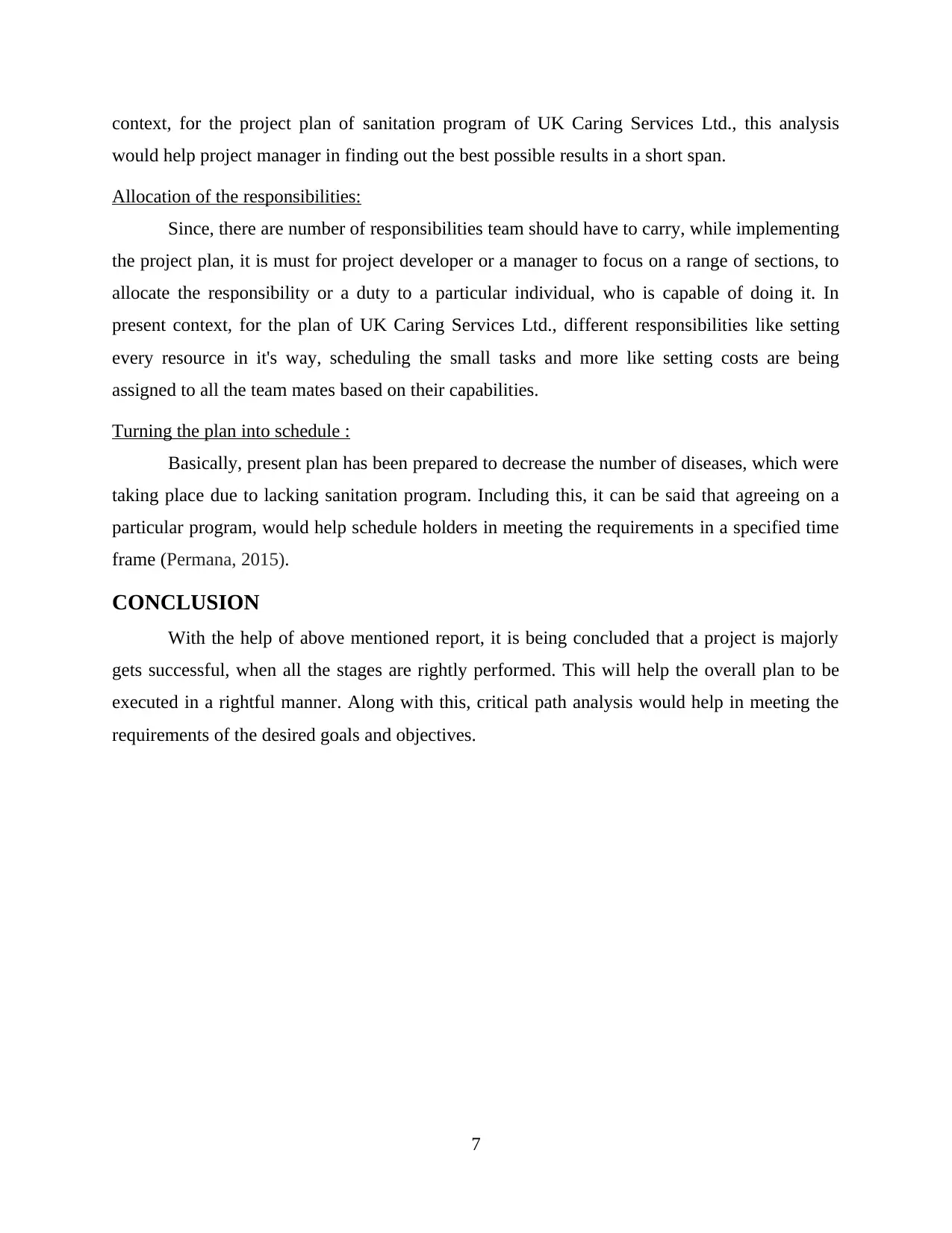
context, for the project plan of sanitation program of UK Caring Services Ltd., this analysis
would help project manager in finding out the best possible results in a short span.
Allocation of the responsibilities:
Since, there are number of responsibilities team should have to carry, while implementing
the project plan, it is must for project developer or a manager to focus on a range of sections, to
allocate the responsibility or a duty to a particular individual, who is capable of doing it. In
present context, for the plan of UK Caring Services Ltd., different responsibilities like setting
every resource in it's way, scheduling the small tasks and more like setting costs are being
assigned to all the team mates based on their capabilities.
Turning the plan into schedule :
Basically, present plan has been prepared to decrease the number of diseases, which were
taking place due to lacking sanitation program. Including this, it can be said that agreeing on a
particular program, would help schedule holders in meeting the requirements in a specified time
frame (Permana, 2015).
CONCLUSION
With the help of above mentioned report, it is being concluded that a project is majorly
gets successful, when all the stages are rightly performed. This will help the overall plan to be
executed in a rightful manner. Along with this, critical path analysis would help in meeting the
requirements of the desired goals and objectives.
7
would help project manager in finding out the best possible results in a short span.
Allocation of the responsibilities:
Since, there are number of responsibilities team should have to carry, while implementing
the project plan, it is must for project developer or a manager to focus on a range of sections, to
allocate the responsibility or a duty to a particular individual, who is capable of doing it. In
present context, for the plan of UK Caring Services Ltd., different responsibilities like setting
every resource in it's way, scheduling the small tasks and more like setting costs are being
assigned to all the team mates based on their capabilities.
Turning the plan into schedule :
Basically, present plan has been prepared to decrease the number of diseases, which were
taking place due to lacking sanitation program. Including this, it can be said that agreeing on a
particular program, would help schedule holders in meeting the requirements in a specified time
frame (Permana, 2015).
CONCLUSION
With the help of above mentioned report, it is being concluded that a project is majorly
gets successful, when all the stages are rightly performed. This will help the overall plan to be
executed in a rightful manner. Along with this, critical path analysis would help in meeting the
requirements of the desired goals and objectives.
7
⊘ This is a preview!⊘
Do you want full access?
Subscribe today to unlock all pages.

Trusted by 1+ million students worldwide
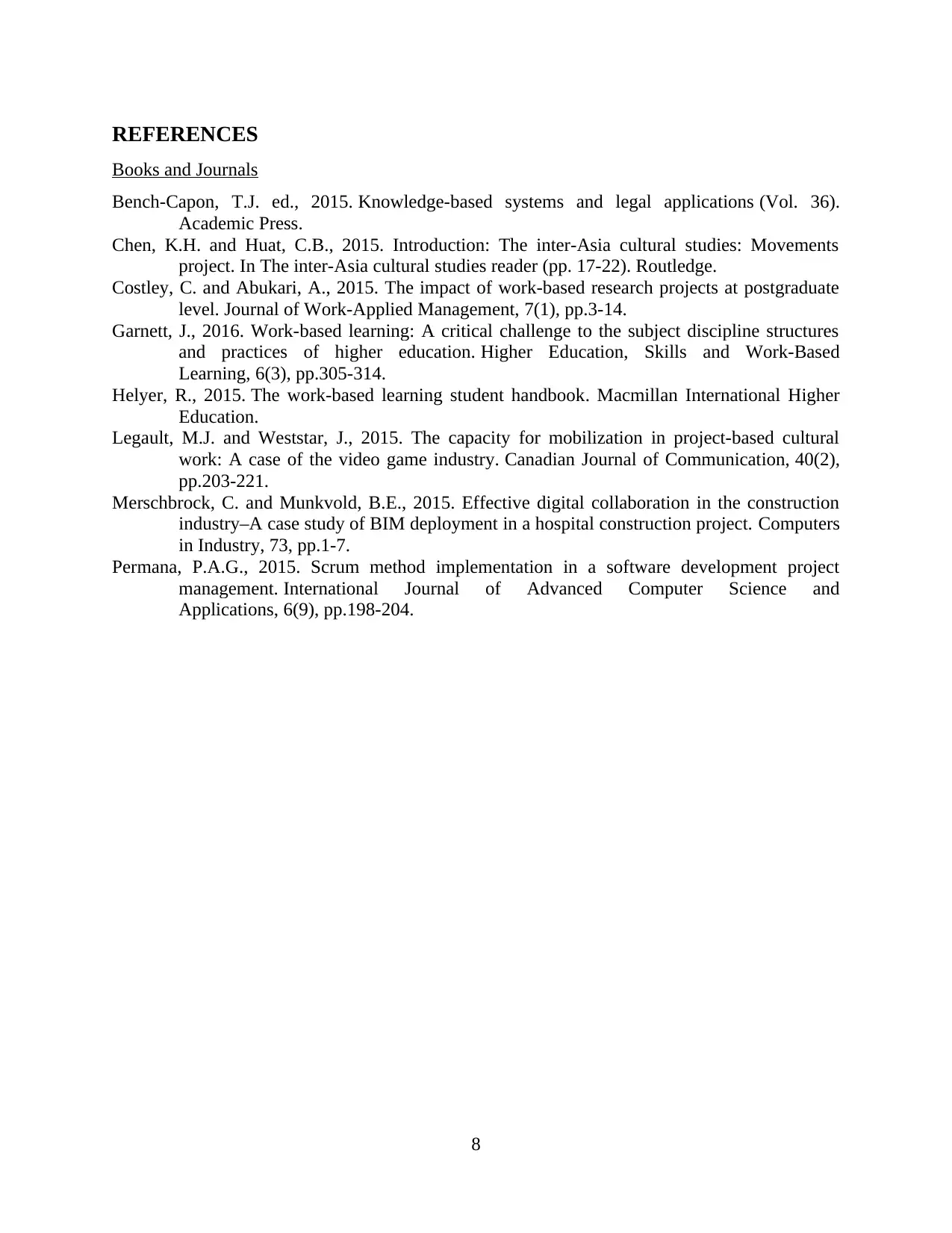
REFERENCES
Books and Journals
Bench-Capon, T.J. ed., 2015. Knowledge-based systems and legal applications (Vol. 36).
Academic Press.
Chen, K.H. and Huat, C.B., 2015. Introduction: The inter-Asia cultural studies: Movements
project. In The inter-Asia cultural studies reader (pp. 17-22). Routledge.
Costley, C. and Abukari, A., 2015. The impact of work-based research projects at postgraduate
level. Journal of Work-Applied Management, 7(1), pp.3-14.
Garnett, J., 2016. Work-based learning: A critical challenge to the subject discipline structures
and practices of higher education. Higher Education, Skills and Work-Based
Learning, 6(3), pp.305-314.
Helyer, R., 2015. The work-based learning student handbook. Macmillan International Higher
Education.
Legault, M.J. and Weststar, J., 2015. The capacity for mobilization in project-based cultural
work: A case of the video game industry. Canadian Journal of Communication, 40(2),
pp.203-221.
Merschbrock, C. and Munkvold, B.E., 2015. Effective digital collaboration in the construction
industry–A case study of BIM deployment in a hospital construction project. Computers
in Industry, 73, pp.1-7.
Permana, P.A.G., 2015. Scrum method implementation in a software development project
management. International Journal of Advanced Computer Science and
Applications, 6(9), pp.198-204.
8
Books and Journals
Bench-Capon, T.J. ed., 2015. Knowledge-based systems and legal applications (Vol. 36).
Academic Press.
Chen, K.H. and Huat, C.B., 2015. Introduction: The inter-Asia cultural studies: Movements
project. In The inter-Asia cultural studies reader (pp. 17-22). Routledge.
Costley, C. and Abukari, A., 2015. The impact of work-based research projects at postgraduate
level. Journal of Work-Applied Management, 7(1), pp.3-14.
Garnett, J., 2016. Work-based learning: A critical challenge to the subject discipline structures
and practices of higher education. Higher Education, Skills and Work-Based
Learning, 6(3), pp.305-314.
Helyer, R., 2015. The work-based learning student handbook. Macmillan International Higher
Education.
Legault, M.J. and Weststar, J., 2015. The capacity for mobilization in project-based cultural
work: A case of the video game industry. Canadian Journal of Communication, 40(2),
pp.203-221.
Merschbrock, C. and Munkvold, B.E., 2015. Effective digital collaboration in the construction
industry–A case study of BIM deployment in a hospital construction project. Computers
in Industry, 73, pp.1-7.
Permana, P.A.G., 2015. Scrum method implementation in a software development project
management. International Journal of Advanced Computer Science and
Applications, 6(9), pp.198-204.
8
1 out of 10
Your All-in-One AI-Powered Toolkit for Academic Success.
+13062052269
info@desklib.com
Available 24*7 on WhatsApp / Email
![[object Object]](/_next/static/media/star-bottom.7253800d.svg)
Unlock your academic potential
Copyright © 2020–2025 A2Z Services. All Rights Reserved. Developed and managed by ZUCOL.

